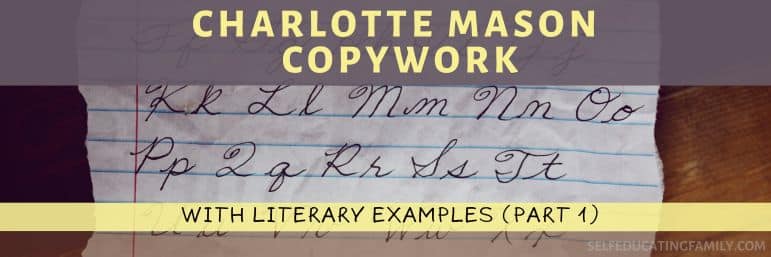What’s inside: Charlotte Mason copywork can come from many different subjects. Homeschoolers recognize the usefulness of copywork to help work patience and attention to detail in their kids. Get some great ideas for your handwriting and copywork lessons in this post.
What is Charlotte Mason Copywork?
Charlotte Mason never actually called it copywork, but she essentially promoted the practice in her educational methods. For more detail on basic copywork, refer to What is Copywork?
This is part 1 of a two-part article on Charlotte Mason Copywork. See Part 2: Free Charlotte Mason Copywork Passages
Quick overview of Charlotte Mason & Copywork
In Home Education, Volume 1 of the Charlotte Mason Series, Miss Mason discusses writing and transcription in Part V: Lessons as Instruments of Education.
She talks about how to start handwriting lessons and then transcription. Lessons are to be short and start with the teacher (you, the homeschool mom) setting the exact content. Eventually, lessons progress to the point where the child selects his own passages to transcribe into a commonplace notebook and finds & makes all corrections as needed.
Brief summary
I like how Simply Charlotte Mason sums it up:
- Present the model (what to copy).
- The child copies.
- The child compares & corrects.
If you are unfamiliar with copywork, read about what it is, or refer to more resources listed at the bottom of this article.
What is Copywork?
Copywork is the process of copying by hand, a well-written sentence, passage or quote.
What is the Purpose of Copywork?
The purpose of copying great passages is to fill your mind with beautifully crafted words while practicing handwriting, and at the same time, exposing your mind to great thoughts, punctuation & grammar, and writing styles.
Homeschoolers today recognize that much can be gained from the practice of copywork, and that it is more of a method than a subject. The content comes from many areas.
Tips for older students:
By “older students” I mean that the child can:
- copy from dictation
- copy whole thoughts at a time accurately – jumping from the source to the blank copy page or commonplace notebook
- handwriting is smooth, legible and automatic, usually cursive.
- all effort is going into the copy as a whole, nothing is going to piece formation of letters, spelling, grammar, punctuation, or losing the place on the page.
For this level, you only need to provide the source of the copywork.
A copywork routine for the child
The child knows what to do if you say, “Use history for Copywork” or “Use your literature book for copywork today.” The child will:
- Select an appropriate piece to copy. Note: make selections for students who are still learning to be independent.
- Pre-read the source.
- Note any difficult spelling to practice.
- Note all punctuation.
- Transcribe once or until correct if necessary.
- Copy from dictation once or until “perfect”. Note: Do not allow too many repeats. You are encouraging the student to take time to make it reasonably “perfect”. You are not raising perfectionists! Remember, each student will be different.
- Transcribe into their commonplace notebook.
Remember, the child will take more than one day to do this at first. As the child gets older, these steps will combine or be eliminated until the child is accurately transcribing directly into the commonplace notebook from the source on the first time. The steps can be revisited when learning a new handwriting style, like architectural small caps, italic, calligraphy, or hand-lettering.
What makes a good “Charlotte Mason-style” source of copywork?
Copywork among homeschoolers using Charlotte Mason methods will generally be from a variety of sources. There is much great writing out there, and the mind likes the exposure to a rich feast of ideas. A child easily tires of copying the same thing again and again. (As would anyone!)
Some moms I know like to vary the source regularly – on a “loop” schedule, almost.
- For instance, Monday is literature copywork.
- Tuesday – history.
- Wednesday – science.
- And so on.
Sometimes, the child will ask to do a copywork selection from their free reading. I always liked to encourage my sons if they went out of their way to ask for a selection. I got a lot of selections from Lord of the Rings that way, but if it made them want to do copywork, I approved!
Resistance
You may have noticed that I just implied that my sons didn’t always love doing copywork. That’s ok. Sometimes doing what is hard pays off. I would like to encourage you to be consistent and keep believing in the method. It does work. I’ll have more to say on that in another post, but for now, keep at it.
- Keep it short. 5 -10 minutes.
- Keep it interesting – lots of different sources, styles, and ideas.
- And keep it fun – sometimes adding in things that you think are clever or amusing can start a great conversation.
Sources of Copywork
- ANY book from ANY subject you are currently working on, including unlikely ones like science or math.
- Favorite authors.
- Famous quotes on the subjects of what you are studying or from the time period in general that you are covering in that semester.
- Non-daily subjects like Geography, Poetry, Shakespeare, Hymns, Folksongs, foreign language, or even Plutarch can work well.
Remember, every student is unique and what excites each one may be different. And you can’t always tell what may spark a love of learning. So give a variety of copywork.
Examples of Copywork from the easiest subjects
Literature, History, and Bible are possibly the easiest subjects to get copywork from. For instance, let’s say you have a student in Year 4 – a younger student but well on her way to independence. Copywork is probably beginning to be easier, but the child probably is not ready to pick all of their selections yet. You can model how to make selections like the following examples.
History
From This Country of Ours by H. E. Marshall (Chapter 53): three sentences about George Washington when he was appointed head of the Continental Army. These could be split over 3 (or more) days if needed:
- “Meanwhile the new army grew daily larger. It was still almost entirely made up of New Englanders, but it was now called the Continental Army, and the Continental Congress appointed George Washington to be commander-in-chief.
- Washington was now a tall, handsome man, little over forty. He was as modest as he was brave, and he accepted the great honour and heavy duties laid upon him with something of dread.
- “Since the Congress desire it,” he said, “I will enter upon this momentous duty, and exert every power I possess in their service. But I beg it may be remembered by every gentleman in this room that I this day declare, with the utmost sincerity, I do not think myself equal to the command I am honoured with.””
Literature
From Kidnapped by Robert Louis Stevenson:
- “But a word once spoken who can recapture it?”
A selection from The Midnight Ride of Paul Revere by Henry Wadsworth Longfellow:
- “In the hour of darkness and peril and need,
The people will waken and listen to hear
The hurrying hoof-beats of that steed,
And the midnight message of Paul Revere.”
From The Life and Adventures of Robinson Crusoe by Daniel Defoe:
- “It is never too late to be wise.”
How to find this kind of copywork
Go to the books you are using and simply search for passages that strike you. The books themselves will have lots of great options. If you are looking for something in particular and the books are in the public domain, you may be able to search online for a passage.
For a Year 4 student, you will probably need to write out the model. This can be done on a board, or you can type the models up in an appropriate handwriting font. As the students begin to select their own passages, they will gradually start to copy directly from their books.
Don’t ask too much at once. Our examples of Year 4 can be tricky – some students are still learning cursive. In that case, select simpler, shorter passages and make sure you model the selection on the page for them. Do this until their handwriting is smooth and flowing with no pauses in the middle of words.
We have a number of free copywork pages in our free library or on specific posts like Free Copywork for Homeschool from Folk Songs.
More on Copywork
Note: This article got so long, I had to truncate it! Read Part 2: Free Charlotte Mason Copywork Passages.
FAQ
1. Model the passage.
2. Have the child copy the passage.
3. The child then “corrects” the passage if necessary.
Examples of copywork come from many sources. Typically, you should select examples from the child’s books. Refer to the specific examples above.
The purpose of copying great passages is to fill your mind with beautifully crafted words while practicing handwriting, and at the same time, exposing your mind to great thoughts, punctuation & grammar, and writing styles.








